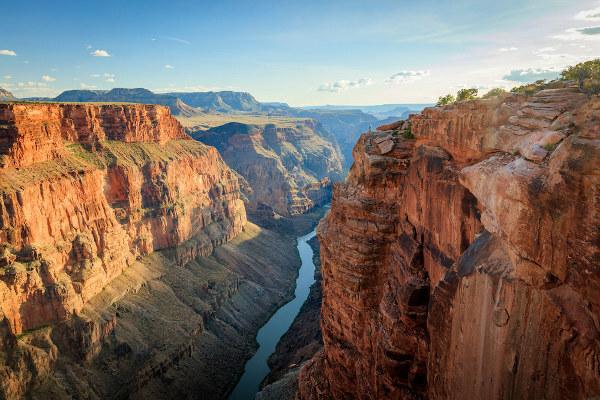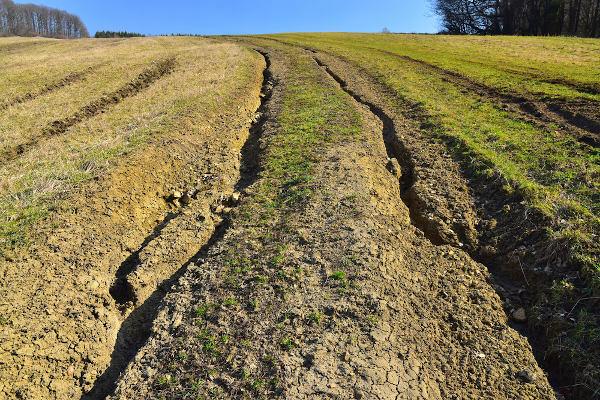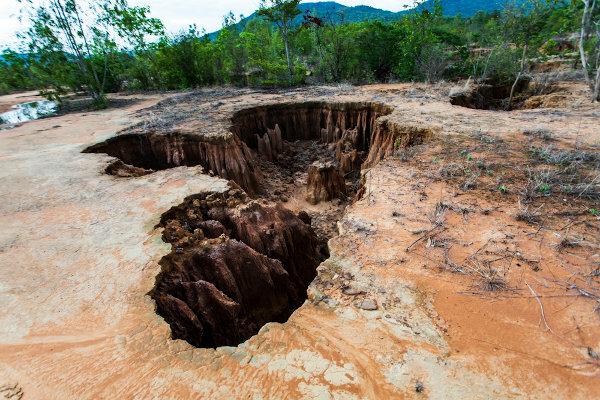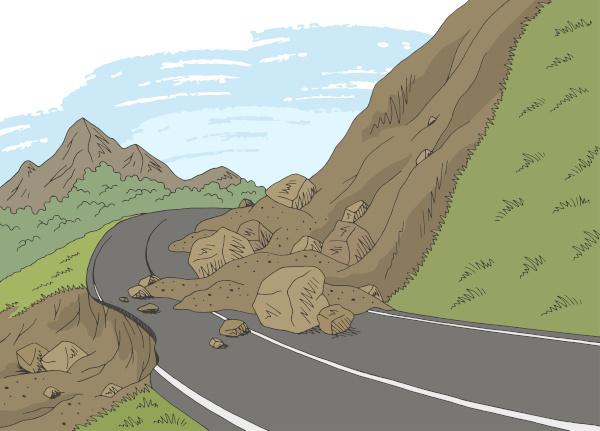THE erosion it is a natural process and present in the planet's dynamics for thousands of years (geological time). This phenomenon consists of the wear of the ground and from the rocks from higher to lower areas, causing the debris sedimentation. Over the years, this wear changes landscapes, river courses, reliefs, among others.
We realize that the planet is a living being, mutable and that changes at every moment. Everything we do is intertwined with these changes. Erosion is a process of transformation occurred outside the earth's crust, being classified in the group of exogenous relief modification factors.
Read too: Hydrographic basins - part of the relief supplied by rivers and their tributaries
Erosion classification
This natural process, but which can be aggravated by man's action, can occur in several ways. With that, we can list the erosive processes by the way they occur. Let's go to the examples:
- Rain Erosion: is caused by the transformation of the relief from the waters of rain (in latin rain = rain). These waters act with great intensity in some regions of the world, especially in tropical and equatorial areas, where precipitation is more intense. As a result, these waters infiltrate the soil, leaving it drenched and full of suitable sediments to be carried to other areas.
- river erosion: is the erosion caused by rivers along its course, on its banks and in its bed. It can be more common in high altitude areas and mountainous reliefs, as gravity tends to make the river faster, leaving the banks more susceptible to the erosive process. Furthermore, it can happen in periods of more intense rain, when the amount of water increases, causing more erosion.
- Ocean/marine erosion: happens with the constant destruction and construction made by the waters of the seas along coastal areas, at the meeting of land and water. This erosion is also known as abrasion and can lead to various forms of relief, such as cliffs, beaches and sandbanks.
- glacial erosion: involves glaciers, which are important items in natural erosion processes. They act like sandpaper on the rock, having their abrasive power greater than that of a river. These erosions currently occur at the poles of the planet and at the peaks of great mountains. However, there was a time in the world when glaciers covered most of the continents, this time known as the Ice Age. With the wear of the ice, which also moves from the highest to the lowest areas, all the soil and rock found along the way were transported, showing all its strength and intensity.
- wind erosion: it is caused by the wind when transporting materials that wear out of rocks and soils. It is more frequent in semiarid, arid and desert areas. When transporting sand particles or even rock fragments, these sediments, along thousands of years, erode the areas they reach, carving arches, rocks or forming stony deserts, like the records from the Sahara desert, in the African continent.
- Anthropogenic erosion (human beings): it is the erosion caused by man, which plays an important role in the modification of the relief, accelerating the process of erosion, whether clearing forests for pastures, roads, cities, or digging tunnels, flattening hills, changing biomes, conquering seas, among other actions. Of the erosions mentioned above, this can be considered the most fleeting and, because of this speed, the most violent with nature. Most of the time, this erosion occurs for social reasons (the construction of houses, for example) and economic reasons (the establishment of an industry).

Types of erosion
Erosive processes, in some regions of nature, are important for the environmental dynamics and soil renewal, as they allow the movement of sediments to other areas, which can transport fertile sediments and contribute to the natural progress of the locality. However, some erosions affect the rhythm of nature, as they cannot be contained in a short period of time. To better understand these peculiarities of erosions, it is important to understand how they are classified, that is, in grooves, ravines and gullies.
These types of erosions vary according to their intensity and their degree of destruction/construction in the soil. On many occasions, these three types of erosive processes can be found from fluvial, pluvial and glacial erosions, but they can coexist with other processes.
You erosive grooves they are the stratifications left in the soil by river erosion. In some regions they are known as the "paths" of water, being characterized by small holes formed by the action of the floods, but they are easy to be recovered.

already the ravines are bigger holes, caused by exaggerated transport of sediments and the high susceptibility of the soil to disintegrate from its mother rock. In general, a soil is more susceptible to ravine formation when there is a lot of rainfall and few trees to hold the soil with their roots. The ravines are found on the slopes of hills that had their original vegetation removed, either by nature or by human action.
At gullies they are more serious processes, which in many cases reach the water table. This type of erosion is the ravine worsening, when the intensity of wear increases, making the soil weak and very susceptible to the formation of huge holes. The removal of vegetation cover contributes to the appearance of gullies, as it increases percolation (underground water infiltration capacity) in the soil.

Factors Affecting Erosion
erosions are landscape altering processes of an area and can be affected by the natural aspects of a region, such as the climate, relief, biomes, between others.
O climate affects erosive processes due to the disposal of rainfall, temperature, amount of winds and solar incidence, as these factors combined can intensify or reduce the erosion of a given area.
As erosion occurs mostly from higher to lower areas, relief is an important aspect to be studied. In flat areas, there is a predominance of sedimentation brought about by erosion, that is, higher areas are more prone to erosion.
The intense presence of trees and plants contributes to erosions occurring with less intensity, as the vegetation cover protects the soil, reducing any natural wear and tear.
See too: Environmental impacts caused by mining
Factors contributing to erosion
The increase in the erosive process can happen naturally or through human action. In nature, weathering causes the disintegration and transformation of rocks. O weathering it is the set of chemical, biological and physical processes that alter the entire rock structure of the soil.
O chemical weathering it happens by the action of water (river, sea or precipitation). When rocks come into contact with water, they are modified internally, as there is an interaction between the water components with the mineral components of the rocks.
already the weatheringphysicist takes care of temperature variation, because, with cold, rocks contract and, with heat, they dilate. O biological weathering it is what contributes the most to erosive processes. it is about the action of living organisms, such as the roots of plants and small animals that live in the soil (ants, earthworms) that enter the rocks and soil, modifying them and opening small channels, which facilitates the occurrence of processes erosive.
consequences of erosion
In large cities with mountainous reliefs, constant rains can cause landslides on undulating terrain. These landslides occur, for the most part, in areas where natural vegetation has been removed for the construction of houses, a problem that is aggravated in poorer areas.
The risk of landslides is greater when hilly areas are deforested by humans, as the soil without vegetation cover is more unprotected from heavy rains.
There is also a serious environmental problem caused by erosion on the banks of rivers when the riparian forest decreases: o siltation. When human action removes part of the vegetation, erosion comes with more force, taking part of the bank into the river, accumulating sediments in its bed. O siltation it can cause the drying of several watercourses, as it reduces the depth and, over the years, causes the loss of aquatic biodiversity.
At human actions they do not always take into account the environmental impacts that are caused when an area is deforested. Severe erosion can start with simple furrows and generate irreversible environmental damage, such as the appearance of ravines and gullies, which can be accelerated by human action.
Also access: Deforestation in the Amazon: causes and consequences
How to prevent erosion?
Erosion, being a natural process, cannot be avoided. However, in urban areas, where erosive damage is greater due to landslides, the disturbances can be mitigated and definitively resolved as long as there is great involvement between the government and the society.
THE no removal of vegetation cover and, consequently, the slope preservation they are actions that help to reduce the erosive effects. Vegetation coverage (planting, reforestation, non-deforestation) minimizes the effects of rain and river erosion, in addition to creating natural barriers that mitigate wind erosion.
In cities, the slopes of hills are inhabited, with deforestation of the area occurring, soil impermeability and interruption of a natural cycle of precipitation. With excess rain, the water that should infiltrate the soil causes runoff, further aggravating the daily situation in these locations.

Other techniques are also used to soften erosive effects, such as terracing (technique of building terraces, steps on the slopes of hills), cultivation in contour lines (alternating crops at different altitudes in the hills), associated planting of crops that expose less the soil, etc.
solved exercises
Question 1 - (Fac. Israeli Health Sciences Albert Einstein SP/2016)
"The recovery and maintenance of areas close to springs and rivers, as well as the disciplined occupation of land and control measures erosion have positive effects on the protection of water resources, both in terms of volume and quality of water present in the spring."
(Eduardo Dibieso. The source of knowledge. São Paulo: Unesp Newspaper No. 309, April 2015, p. 8)

It's not enough just to rain. Actions to protect water resources stored in water sources are of great importance. In this regard it is correct to say that
a) riparian forests that protect our rivers and dams are losing their protection effectiveness, because with the constant droughts that hit us, they are disappearing.
b) the main form of protection of water resources in rivers and springs is the recovery and maintenance, in adequate dimensions, of riparian forests.
c) in view of the seriousness of the water crises, our environmental laws have become stricter, which already generates positive effects in the areas of urban springs.
d) what is essential in terms of water resources is the protection of springs with the maintenance of forests. With this, the adequate existence of a river is guaranteed.
Resolution
Alternative B. Riparian forests are so called because they protect rivers from silting, just as human eyelashes protect the eyes from impurities brought in by the air. The maintenance of these forests is essential for the preservation of life in a river.
Question 2 - (University Center of Franca SP/2016)
Deforestation results, in large part, from the exploitation of natural resources and the commercial use of wood. From an environmental point of view, they are consequences of deforestation
a) soil erosion and the reduction of biodiversity.
b) the imbalance in the ecosystem and the reduction of erosive processes.
c) reducing the flow of rivers and maintaining biodiversity.
d) the rise in temperature and the increase in river flow.
e) air pollution and increased rainfall.
Resolution
Alternative A. Deforestation significantly contributes to increased erosion and reduces biodiversity in the area, driving away fauna.
By Attila Matthias
Geography teacher

